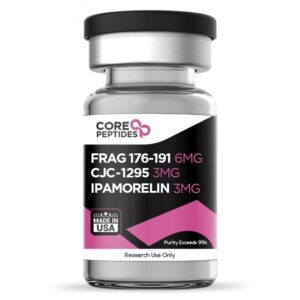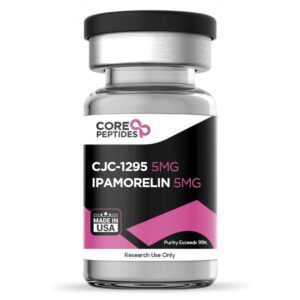Description
Ipamorelin Peptide – Research Peptide Overview
Ipamorelin is a synthetic pentapeptide (Aib-His-D-2-Nal-D-Phe-Lys-NH₂) classified as a Growth Hormone Secretagogue (GHS). It was specifically developed to target and activate ghrelin receptors (GHS-R) within the pituitary gland, which are associated with the regulation and release of human growth hormone (hGH). Unlike earlier GHS compounds, Ipamorelin is noted for its high selectivity, potentially stimulating growth hormone production without significantly influencing other pituitary hormones such as prolactin or ACTH.
Chemical Properties
-
Molecular Formula: C₃₈H₄₉N₉O₅
-
Molecular Weight: 711.86 g/mol
-
Other Names: NNC 26-0161
Research and Mechanisms of Action
1. Growth Hormone Secretion
Preclinical and clinical studies indicate that Ipamorelin may stimulate the release of hGH by binding selectively to growth hormone secretagogue receptors on somatotroph cells in the anterior pituitary. This interaction may activate phospholipase C (PLC), leading to the production of inositol triphosphate (IP3) and diacylglycerol (DAG)—secondary messengers that may trigger intracellular calcium release and protein kinase C (PKC) activation, ultimately prompting the exocytosis of growth hormone vesicles.
In early-phase human trials, repeated administration of Ipamorelin was associated with a significant rise in circulating growth hormone levels, suggesting that the peptide’s effect may be comparable to that of natural growth hormone-releasing hormone (GHRH).
2. Selective Receptor Binding
Research published in Endocrinology (1998) identified Ipamorelin as one of the first highly selective GHS-R agonists. Unlike non-selective peptides such as GHRP-6, Ipamorelin appears to act exclusively on GH release pathways without affecting other endocrine axes, potentially making it a promising research candidate for selective hormonal regulation studies.
3. Bone Density and Tissue Growth
Studies conducted on murine models suggest that Ipamorelin may promote bone mineral density (BMD) and bone mineral content (BMC) by enhancing osteoblastic activity. Through increased hGH and IGF-1 synthesis, the peptide may encourage bone formation and structural integrity, especially in skeletal models where bone mass loss is induced.
4. Digestive Motility and Gastric Function
Experimental studies have also explored Ipamorelin’s influence on gastric emptying and smooth muscle contractility. In rodent models with induced gastric dysmotility, Ipamorelin administration appeared to accelerate gastric emptying and enhance peristaltic motion. This effect, similar to that of ghrelin, suggests a possible regulatory role in digestive motility research.
5. Appetite and Energy Regulation
Ipamorelin’s affinity for ghrelin receptors has led scientists to investigate its potential effects on appetite stimulation and energy metabolism. In animal models, chronic exposure appeared to result in a moderate increase in body weight and adipose tissue accumulation, potentially linked to elevated leptin levels and altered hunger signaling. These findings have made Ipamorelin an area of interest in metabolic and appetite regulation research.
6. Nitrogen Balance and Anabolic Pathways
Further studies indicate that Ipamorelin may influence nitrogen balance by modulating hepatic urea cycle enzyme expression. In catabolic-state models, Ipamorelin exposure was associated with reduced urea synthesis and improved nitrogen retention—suggesting a possible anabolic effect mediated by enhanced protein synthesis and reduced nitrogen excretion.
Summary
Ipamorelin peptide represents a selective, potent growth hormone secretagogue that may stimulate GH release without significantly affecting other hormones. Its potential actions on growth, metabolism, bone structure, digestion, and cellular repair make it a valuable compound for scientific and preclinical research.
Disclaimer
Ipamorelin is supplied for research and laboratory use only. It is not approved for human consumption, medical, or veterinary use. Please ensure all handling and experimental applications comply with institutional and regional research regulations.
References
-
Raun K. et al., Endocrinology, 1998 – “Ipamorelin, the first selective growth hormone secretagogue.”
-
Sinha D.K. et al., Translational Andrology and Urology, 2020.
-
Jiménez-Reina L. et al., Histology and Histopathology, 2002.
-
Gobburu J.V.S. et al., Pharmaceutical Research, 1999.
-
Svensson J. et al., Journal of Endocrinology, 2000.
-
Greenwood-Van Meerveld B. et al., Journal of Experimental Pharmacology, 2012





Reviews
There are no reviews yet.